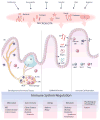Resident commensals shaping immunity
- PMID: 23830047
- PMCID: PMC3775925
- DOI: 10.1016/j.coi.2013.06.001
Resident commensals shaping immunity
Abstract
All animals coexist with myriad commensal microorganisms in a symbiotic relationship that plays a key role in health and disease. Continuous commensal-host interactions profoundly affect the development and regulation of the host's immune system. The complex interaction of the commensal microbiota with the immune system is a topic of substantial interest. An understanding of these interactions and the mechanisms through which commensal microbes actively shape host immunity may yield new insights into the pathogenesis of many immune-mediated diseases and lead to new prophylactic and therapeutic interventions. This review examines recent advances in this field and their potential implications not just for the colonized tissues but also for the entire immune system.
Copyright © 2013 Elsevier Ltd. All rights reserved.
Figures

Similar articles
-
Symbiotic and antibiotic interactions between gut commensal microbiota and host immune system.Medicina (Kaunas). 2015;51(2):69-75. doi: 10.1016/j.medici.2015.03.001. Epub 2015 Mar 24. Medicina (Kaunas). 2015. PMID: 25975874 Review.
-
Immune-microbiota interactions in health and disease.Clin Immunol. 2015 Aug;159(2):122-127. doi: 10.1016/j.clim.2015.05.014. Epub 2015 Jun 30. Clin Immunol. 2015. PMID: 26141651 Free PMC article. Review.
-
Blowing on embers: commensal microbiota and our immune system.Front Immunol. 2014 Jul 28;5:318. doi: 10.3389/fimmu.2014.00318. eCollection 2014. Front Immunol. 2014. PMID: 25120539 Free PMC article. Review.
-
An expanding stage for commensal microbes in host immune regulation.Cell Mol Immunol. 2017 Apr;14(4):339-348. doi: 10.1038/cmi.2016.64. Epub 2017 Jan 9. Cell Mol Immunol. 2017. PMID: 28065939 Free PMC article. Review.
-
B Cells and Microbiota in Autoimmunity.Int J Mol Sci. 2021 May 3;22(9):4846. doi: 10.3390/ijms22094846. Int J Mol Sci. 2021. PMID: 34063669 Free PMC article. Review.
Cited by
-
The microbiome in asthma.J Allergy Clin Immunol. 2015 Jan;135(1):25-30. doi: 10.1016/j.jaci.2014.11.011. J Allergy Clin Immunol. 2015. PMID: 25567040 Free PMC article. Review.
-
Symbiotic microbiome Staphylococcus epidermidis restricts IL-33 production in allergic nasal epithelium via limiting the cellular necroptosis.BMC Microbiol. 2023 May 26;23(1):154. doi: 10.1186/s12866-023-02898-7. BMC Microbiol. 2023. PMID: 37237381 Free PMC article.
-
Longitudinal Survey of Fungi in the Human Gut: ITS Profiling, Phenotyping, and Colonization.Front Microbiol. 2019 Jul 10;10:1575. doi: 10.3389/fmicb.2019.01575. eCollection 2019. Front Microbiol. 2019. PMID: 31354669 Free PMC article.
-
Prevalence of Staphylococcus Species Colonization in Healthy and Sick Cats.Biomed Res Int. 2019 Jan 20;2019:4360525. doi: 10.1155/2019/4360525. eCollection 2019. Biomed Res Int. 2019. PMID: 30800668 Free PMC article.
-
New developments providing mechanistic insight into the impact of the microbiota on allergic disease.Clin Immunol. 2015 Aug;159(2):170-6. doi: 10.1016/j.clim.2015.05.007. Epub 2015 May 16. Clin Immunol. 2015. PMID: 25988860 Free PMC article. Review.
References
-
- Erkosar B, Storelli G, Defaye A, Leulier F. Host-intestinal microbiota mutualism: “learning on the fly”. Cell host & microbe. 2013;13:8–14. - PubMed
-
- Iliev ID, Funari VA, Taylor KD, Nguyen Q, Reyes CN, Strom SP, Brown J, Becker CA, Fleshner PR, Dubinsky M, et al. Interactions between commensal fungi and the C-type lectin receptor Dectin-1 influence colitis. Science (New York, NY) 2012;336:1314–7. In this paper, the authors identify gut mycobiome and show that Dectin 1-deficient (Clec7a−/−) mice are more susceptible to DSS-induced inflammation. In humans, a single-nucleotide polymorphism in CLEC7A is strongly associated with medically refractory ulcerative colitis. - PMC - PubMed
Publication types
MeSH terms
Substances
Grants and funding
LinkOut - more resources
Full Text Sources
Other Literature Sources
Medical

